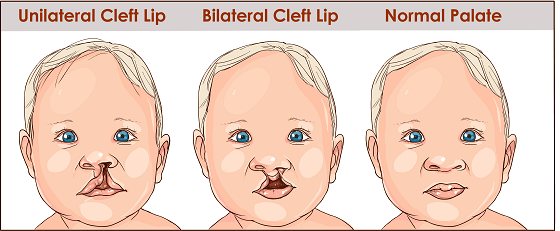Cleft lip and cleft palate is the facial condition where a split created in the lip or in the roof of the mouth. Typically it occurs when facial formations that are developing in an unborn baby don’t close completely.
Cleft lip and cleft palate are among the most common birth flaws. They most commonly occur as separate birth defects but are also associated with many inherited genetic conditions or syndromes.
Having a baby born with a cleft can be disturbing, but it can be corrected. In most babies, a series of surgeries can rebuild normal function and achieve a more healthy appearance with minimal scarring.
Causes –
Cleft lip and cleft palate happen when tissues in the baby’s face and mouth don’t fuse properly. Normally, during the second and third month of pregnancy the tissues that make up the lip and mouth fuse together. But in babies with cleft lip and cleft palate, the fusion never takes place only part way, leaving an opening (cleft).
Researchers conclude that most cases of cleft lip and cleft palate are caused by a combination of reasons genetic and environmental factors. In many babies, a definite cause isn’t identified.

What is the treatment available for Cleft lip and Cleft Palate?
The goal of the cleft lip and Cleft Palate treatment is to improve a child’s ability to eat and speaking. This treatment also aims to achieve a normal facial appearance of the baby.
Cleft lip
To correct the cleft lip the surgery will be performed within 2- months after the baby’s birth. Usually, the rule of 10 will be followed in this surgery.
This rule says the baby is at least 10 weeks of age; should weigh at least 10 pounds and should have at least 10g hemoglobin count. The most popular procedure to repair a cleft lip is the Millard procedure pioneered by Ralph Millard.
Pre-surgical methods in some cases of a severe bi-lateral complete cleft, the premaxillary segment will be protruded far outside the mouth. Nasoalveolar molding prior to surgery can develop long-term nasal symmetry among patients with complete unilateral cleft lip-cleft palate patients connected to correction by surgery alone.
Cleft palate
Many times cleft palate is temporarily covered by a palatal obturator (a prosthetic device made to fit the roof of the mouth covering the gap). A cleft palate can also be corrected by surgery, normally performed between 6 and 12 months.
Speech and hearing
A tympanostomy tube is often inserted into the eardrum to aerate the middle ear. This is often helpful for the hearing ability of the child. Speech-language pathology can be very useful to resolve speech difficulties associated with cleft palate.
Expert opinion
Dr. Rupali Gujar Dental Director at Sabka Dentist says “A child may feel discomfort while having food or in other activities. Understanding the child’s comfort is important during this period”.
Dr. Priyanka Shinghore Dental director at Sabka dentist says “Follow all the prescription of doctors and do visit to your doctor for regular follow-ups".











One thought on “What every parent should know about cleft lip and palate”
a must read article for parents